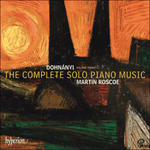Dohnányi’s
Naila Waltz, from Delibes’s ballet
La source, ou Naila, is based on a ‘Pas des fleurs’ that Delibes actually wrote as a divertissement for a ballet by another composer, one year after composing
La source. The ‘Pas des fleurs’ was later incorporated into a production of
La source and became one of the work’s most memorable numbers. As with his arrangements of the other waltzes, Dohnányi follows the basic form of Delibes’s original, but enhances the melodic and harmonic vocabulary by infusing his own distinctive voice as a master composer and virtuoso pianist. Dohnányi created the
Naila paraphrase in 1897, shortly after graduating from the Academy of Music in Budapest. The work quickly became a staple of his repertoire as a concert finale, but he did not publish the work until 1916, when he joined the faculty of the Liszt Academy.
from notes by James A Grymes © 2015
La
Valse de Naila, tirée du ballet
La source, ou Naila de Léo Delibes, repose sur un «Pas des fleurs» conçu pour servir de divertissement dans le ballet d’un autre compositeur avant d’être incorporé dans une production de
La source, écrit un an plus tôt. Il en deviendra un des plus mémorables numéros. Comme pour ses arrangements des autres valses, Dohnányi suit la forme basique de l’original de Delibes mais rehausse le vocabulaire mélodico-harmonique en instillant son style de maître compositeur et de pianiste virtuose. Il créa la paraphrase
Naila en 1897, peu après avoir obtenu son diplôme de l’Académie de musique de Budapest. Cette œuvre devint vite, pour lui, un final de concert incontournable, mais il ne la publia pas avant 1916, date à laquelle il rejoignit l’Académie Liszt.
extrait des notes rédigées par James A Grymes © 2015
Français: Hypérion
Dohnányis
Walzer Naila aus Delibes’ Ballett
La source, ou Naila basiert auf einem „Pas des fleurs“, den Delibes eigentlich als Divertissement für ein Ballett eines anderen Komponisten ein Jahr nach der Komposition von
La source geschrieben hat. Der „Pas des fleurs“ wurde später in eine Aufführung von La source aufgenommen und zu einem der einprägsamsten Stücke des Werkes. Wie bei seinen Bearbeitungen der anderen Walzer hielt Dohnányi sich an die Grundform von Delibes’ Original, reicherte jedoch das melodische und harmonische Vokabular an, indem er es mit seinem eigenen ausgeprägten Stil als meisterhafter Komponist und Klaviervirtuose erfüllte. Dohnányi schrieb die
Naila-Paraphrase im Jahre 1897, kurz nach seinem Abschluß an der Budapester Musikakademie. Sie gelangte in seinem Repertoire schnell zu großer Bedeutung als Konzertfinale, aber er veröffentlichte das Werk erst 1916, als er an der Liszt-Akademie lehrte.
aus dem Begleittext von James A Grymes © 2015
Deutsch: Christiane Frobenius

 Dohnányi: The Complete Solo Piano Music, Vol. 3
Dohnányi: The Complete Solo Piano Music, Vol. 3 Wilhelm Backhaus - The complete acoustic and selected early electric recordings
Wilhelm Backhaus - The complete acoustic and selected early electric recordings
